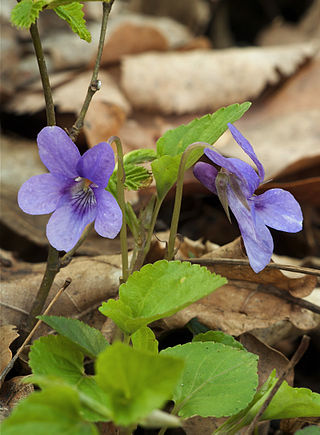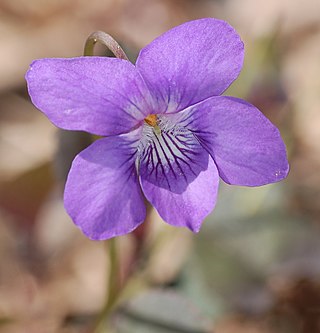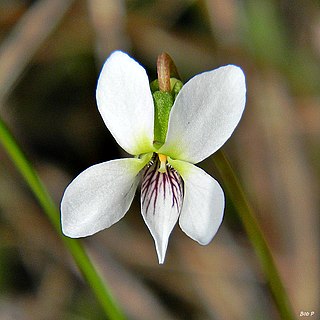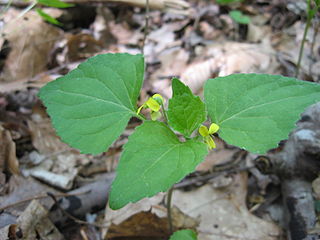
Viola is a genus of flowering plants in the violet family Violaceae. It is the largest genus in the family, containing over 680 species. Most species are found in the temperate Northern Hemisphere; however, some are also found in widely divergent areas such as Hawaii, Australasia, and the Andes.

Viola riviniana, the common dog-violet, is a species of flowering plant in the family Violaceae, native to Eurasia and Africa. It is also called wood violet and dog violet. It inhabits woodland edges, grassland and shady hedge banks. It is found in all soils except those which are acid or very wet.

Viola odorata is a species of flowering plant in the family Violaceae, native to Europe and Asia. This small hardy herbaceous perennial is commonly known as wood violet, sweet violet, English violet, common violet, florist's violet, or garden violet. It has been introduced into the Americas and Australia.
Viola appalachiensis, the Appalachian blue violet, also known as Appalachian violet and Henry's violet is a Viola native to the Appalachian Mountains in the Eastern United States.

Viola sororia, known commonly as the common blue violet, is a short-stemmed herbaceous perennial plant native to eastern North America. It is known by a number of common names, including common meadow violet, purple violet, woolly blue violet, hooded violet, and wood violet.

Viola purpurea is a species of violet with yellow flowers and the common name goosefoot violet.

Viola adunca is a species of violet known by the common names hookedspur violet, early blue violet, sand violet, and western dog violet. It is native to meadows and forests of western North America, Canada, and the northern contiguous United States.

Viola labradorica, commonly known as alpine violet, American dog violet, dog violet or Labrador violet, is a perennial herbaceous flowering plant. It is native to Greenland, eastern Canada, and the eastern United States. The plant sold as Viola labradorica by nurseries is Viola riviniana.

Viola betonicifolia, commonly known as the arrowhead violet, showy violet or mountain violet, is a small perennial of the genus Viola, which contains pansies and violets. It occurs from India and Pakistan in southern Asia throughout eastern Australia and Tasmania. It grows in shaded habitat in forests.

Viola reichenbachiana, also known as the early dog-violet, pale wood violet, slender wood violet, hedge violet, or wood dog violet, is a species of flowering plant in the Viola genus. This species hybridises with Viola riviniana, the common dog-violet, to produce Viola × bavarica. The plant is named after the 19th century botanist Ludwig Reichenbach. It is a rhizomatous herbaceous perennial that is widely known for its purple petals, and it typically resides along road banks or among other rich vegetation, as other wild pansies do. The name dog violet refers to its lack of scent, making it supposedly only fit for dogs.

Viola nephrophylla syn. Viola nephrophylla Greene f. albinea (Farw.), Viola pratincola Greene, Viola retusa Greene ) is an annual or perennial forb in the Violet family (Violaceae) native to North America.

Viola nuttallii is a perennial herbaceous plant in the violet family (Violaceae), and is one of the few violet species with lanceolate leaves. It is native to the western Canada and the north-central and western United States, appearing in upper steppe lands, forests, and alpine ridges.
Viola helena, commonly known as Wahiawa stream violet, is a rare species of flowering plant in the violet family. It is endemic to Hawaii, where it is known only from the Wahiawa Mountains of Kauai. It is threatened by exotic plant species and feral pigs. It is a federally listed endangered species of the United States.

Viola oahuensis is a rare species of flowering plant in the violet family known by the common name Oahu violet.

Viola lanceolata, commonly known as lance-leaved violet or bog white violet, is a small group of stemless white-flowered violets. It is an ornamental plant in the Violaceae family, part of the genus Viola. It gets its name from its lanceolate leaf shape and from the habitats in which it thrives.

Viola selkirkii is a species of violet known by the common names Selkirk's violet and great-spur violet. It is native throughout the Northern Hemisphere, its distribution circumboreal.

Viola tripartita is a species of violet known by the common name threepart violet. It is native to Eastern North America, being primarily found in the Southern Appalachian Mountains. Its preferred habitat is rich, mesic forests over calcareous rocks. It is a small perennial herb that has yellow flowers in the spring. It is distinguished from other caulescent yellow violets native to the area by having leaves that are wider than long which have a cuneate base.

Viola calcarata is a species of genus Viola that grows on mountains of south-eastern Europe. It is commonly known as long-spurred violet or mountain violet. It is a herbaceous flowering perennial plant.

Viola flettii is a species of violet known by the common name Olympic violet. Native to the northeastern and eastern Olympic Mountains of Washington in northwestern United States, it occurs on rocky outcrops and talus at subalpine and alpine elevations, i.e., from 1,340–2,000 metres (4,400–6,560 ft), and blooms from June through August. This rhizomatous herb produces a hairless stem reaching a maximum height of a few centimeters to around 15 centimeters. The basal leaves have purple-veined green reniform blades borne on petioles. Leaves on the flower stem are similar but smaller. A solitary flower is borne on a slender upright stem. It has five purplish-violet petals with yellowish bases, the lower three with purple veins. The lateral pair are bearded as is the stigma. The spur on the lowest petal is much shorter than the petal.

Viola gracilis, also known as the Olympian violet, is a species of flowering plant within the family Violaceae.

















